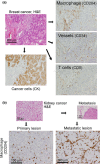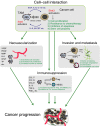Clinical significance of macrophage heterogeneity in human malignant tumors
- PMID: 24168081
- PMCID: PMC4317877
- DOI: 10.1111/cas.12314
Clinical significance of macrophage heterogeneity in human malignant tumors
Abstract
The fact that various immune cells, including macrophages, can be found in tumor tissue has long been known. With the recent introduction of the novel concept of macrophage differentiation into a classically activated phenotype (M1) and an alternatively activated phenotype (M2), the role of tumor-associated macrophages (TAMs) is gradually beginning to be elucidated. Specifically, in human malignant tumors, TAMs that have differentiated into M2 macrophages act as "protumoral macrophages" and contribute to the progression of disease. Based on recent basic and preclinical research, TAMs that have differentiated into protumoral or M2 macrophages are believed to be intimately involved in the angiogenesis, immunosuppression, and activation of tumor cells. In this paper, we specifically discuss both the role of TAMs in human malignant tumors and the cell-cell interactions between TAMs and tumor cells.
Keywords: CD163; Cancer; M2; TAM; macrophage.
© 2013 The Authors. Cancer Science published by Wiley Publishing Asia Pty Ltd on behalf of Japanese Cancer Association.
Figures


Similar articles
-
Tumor-associated macrophages: from basic research to clinical application.J Hematol Oncol. 2017 Feb 28;10(1):58. doi: 10.1186/s13045-017-0430-2. J Hematol Oncol. 2017. PMID: 28241846 Free PMC article. Review.
-
Redefining Tumor-Associated Macrophage Subpopulations and Functions in the Tumor Microenvironment.Front Immunol. 2020 Aug 4;11:1731. doi: 10.3389/fimmu.2020.01731. eCollection 2020. Front Immunol. 2020. PMID: 32849616 Free PMC article. Review.
-
Human breast cancer cells educate macrophages toward the M2 activation status.Breast Cancer Res. 2015 Aug 5;17(1):101. doi: 10.1186/s13058-015-0621-0. Breast Cancer Res. 2015. PMID: 26243145 Free PMC article.
-
Tumor-associated macrophages, potential targets for cancer treatment.Biomark Res. 2017 Aug 8;5:25. doi: 10.1186/s40364-017-0106-7. eCollection 2017. Biomark Res. 2017. PMID: 28804638 Free PMC article. Review.
-
Role of tumor-associated macrophages in human malignancies: friend or foe?Pathol Int. 2016 Sep;66(9):491-505. doi: 10.1111/pin.12440. Epub 2016 Jul 21. Pathol Int. 2016. PMID: 27444136 Review.
Cited by
-
The role of macrophages in anti-tumor immune responses: pathological significance and potential as therapeutic targets.Hum Cell. 2021 Jul;34(4):1031-1039. doi: 10.1007/s13577-021-00514-2. Epub 2021 Apr 27. Hum Cell. 2021. PMID: 33905102 Review.
-
Significance of macrophage infiltration in the prognosis of lung adenocarcinoma patients evaluated by scRNA and bulkRNA analysis.Front Immunol. 2022 Oct 12;13:1028440. doi: 10.3389/fimmu.2022.1028440. eCollection 2022. Front Immunol. 2022. PMID: 36311801 Free PMC article.
-
Crosstalk between tumor-associated macrophages and tumor cells promotes chemoresistance via CXCL5/PI3K/AKT/mTOR pathway in gastric cancer.Cancer Cell Int. 2022 Sep 23;22(1):290. doi: 10.1186/s12935-022-02717-5. Cancer Cell Int. 2022. PMID: 36151545 Free PMC article.
-
TREM2 Is Associated with Advanced Stages and Inferior Prognosis in Oral Squamous Cell Carcinoma.Cancers (Basel). 2022 Sep 24;14(19):4635. doi: 10.3390/cancers14194635. Cancers (Basel). 2022. PMID: 36230558 Free PMC article.
-
The immunosuppression pathway of tumor-associated macrophages is controlled by heme oxygenase-1 in glioblastoma patients.Int J Cancer. 2022 Dec 15;151(12):2265-2277. doi: 10.1002/ijc.34270. Epub 2022 Sep 15. Int J Cancer. 2022. PMID: 36054818 Free PMC article.
References
-
- Monis B, Weinberg T. Cytochemical study of esterase activity of human neoplasms and stromal macrophages. Cancer. 1961;14:369–77. - PubMed
-
- Underwood JC, Carr I. The ultrastructure of the lymphoreticular cells in non-lymphoid human neoplasms. Virchows Arch B Cell Pathol. 1972;12:39–50. - PubMed
-
- Kreutz M, Fritsche J, Andreesen R. Macrophages in tumor biology. In: Burke B, Lewis CE, editors. The Macrophage. 2nd edn. Oxford, UK: Oxford Univ. Press; 2002. pp. 458–89.
-
- Tagliabue A, Mantovani A, Kilgallen M, Herberman RB, McCoy JL. Natural cytotoxicity of mouse monocytes and macrophages. J Immunol. 1979;122:2363–70. - PubMed
Publication types
MeSH terms
LinkOut - more resources
Full Text Sources
Other Literature Sources
Research Materials

